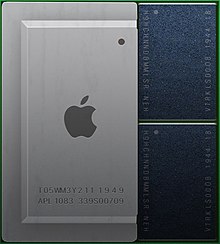Apple A12Z
 | |
| General information | |
|---|---|
| Launched | March 18, 2020 |
| Discontinued | April 20, 2021 |
| Designed by | Apple Inc. |
| Common manufacturer(s) |
|
| Product code | APL1083 |
| Max. CPU clock rate | to 2.49 GHz |
| Cache | |
| L1 cache | 128 KB instruction, 128 KB data |
| L2 cache | 8 MB |
| Architecture and classification | |
| Application | Mobile |
| Technology node | 7 nm |
| Microarchitecture | Vortex and Tempest |
| Instruction set | A64 – ARMv8.3-A |
| Physical specifications | |
| Cores |
|
| GPU(s) | Apple designed 8-Core |
| Products, models, variants | |
| Variant(s) |
|
| History | |
| Predecessor | Apple A12X |
| Successor | Apple M1 |
The Apple A12Z Bionic is a 64-bit ARM-based system on a chip (SoC) designed by Apple Inc.
The chip was unveiled on March 18, 2020, as part of a press release for the iPad Pro (2020), the first device to use it.[1] Apple officials touted the chip as faster than most Windows laptops of the time. The chip has an 8-core GPU, one more core than its predecessor, the Apple A12X, which enables better and faster 4K video editing, rendering, and augmented reality. The chip also features tuned performance controllers and a better thermal architecture, which may allow for higher clock speeds.[2] On the iPad Pro it is paired with 6 GB of LPDDR4X RAM.[3] Both the A12Z and A12X are the same, with the A12Z having all 8 GPU cores enabled instead of just 7.[4]
According to floor plan analysis by technology patents firm TechInsights, the A12Z Bionic is the same as the A12X chip, but with an extra GPU core enabled.[5][6] AnandTech hypothesized that the A12Z is a re-binned variant of the A12X, which is a common practice in semiconductor manufacturing, allowing the new chip to perform somewhat better than the previous generation because of slightly higher-quality integrated circuits.[2]
The support of Codecs by decoding and encoding is extended to HEVC 264, 265 (8/10bit), VP 8, VP9 and JPEG. AVC and VC1 are available for decoding. AV1 is not supported by hardware. [7]
At its 2020 Worldwide Developer's Conference, Apple introduced a prototype ARM-based Mac based on the A12Z with 16 GB RAM in a Mac mini enclosure, the first Macintosh computer to use an Apple in-house processor, and the only one to use an A-series processor.[8]
Products that include the Apple A12Z Bionic[]
- iPad Pro 11-inch (2nd generation, 2020)
- iPad Pro 12.9-inch (4th generation, 2020)
- Developer Transition Kit (ARM, 2020)
See also[]
- Apple silicon, the range of ARM-based mobile processors designed by Apple
- Apple A12
- Apple A12X
References[]
- ^ Miller, Chance (March 18, 2020). "Apple unveils new iPad Pro with backlit Magic Keyboard case, available to order today". 9to5Mac. Retrieved March 18, 2020.
- ^ a b Shilov, Anton. "Apple Unveils New iPad Pro: A12Z Bionic, Camera w/ Depth Sensor for AR, Keyboard w/ Trackpad". www.anandtech.com. Retrieved March 30, 2020.
- ^ Espósito, Felipe (March 18, 2020). "All 2020 iPad Pro models feature 6GB of RAM, same U1 chip as iPhone 11". 9to5Mac. Retrieved March 18, 2020.
- ^ "Looking at the Apple A12Z Bionic System on Chip | TechInsights". www.techinsights.com. Retrieved 2020-08-30.
- ^ Miller, Chance (March 26, 2020). "Report claims new iPad Pro's A12Z Bionic chip is just a 'renamed A12X with an enabled GPU core'". 9to5Mac. Retrieved March 29, 2020.
- ^ Clover, Juli (April 13, 2020). "A12Z Chip in iPad Pro Confirmed to Be Same As A12X, But With Extra GPU Core Enabled". MacRumors. Retrieved April 14, 2020.
- ^ "Apple A12".
- ^ "Apple announces Mac transition to Apple silicon". Apple Newsroom. Retrieved 2020-08-30.
- Apple Inc. mobile processors
- ARM architecture
- Computer-related introductions in 2020
